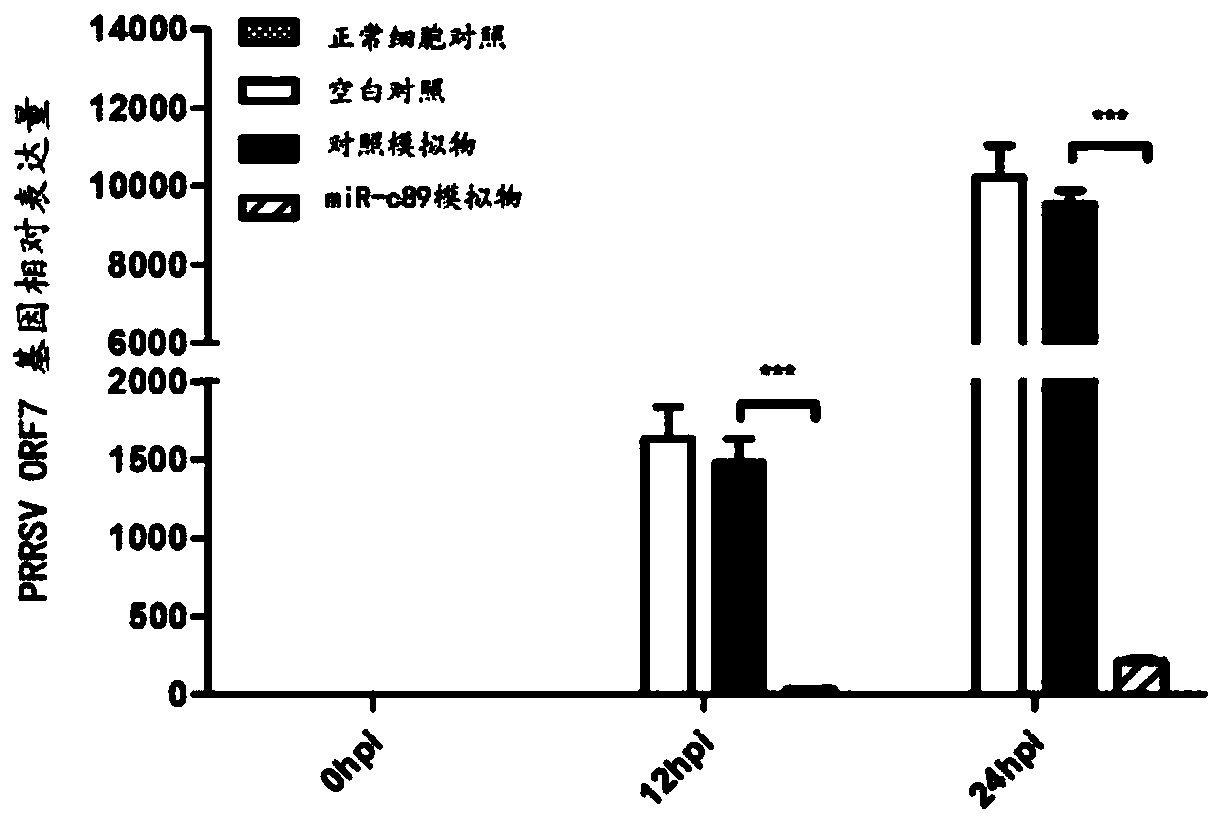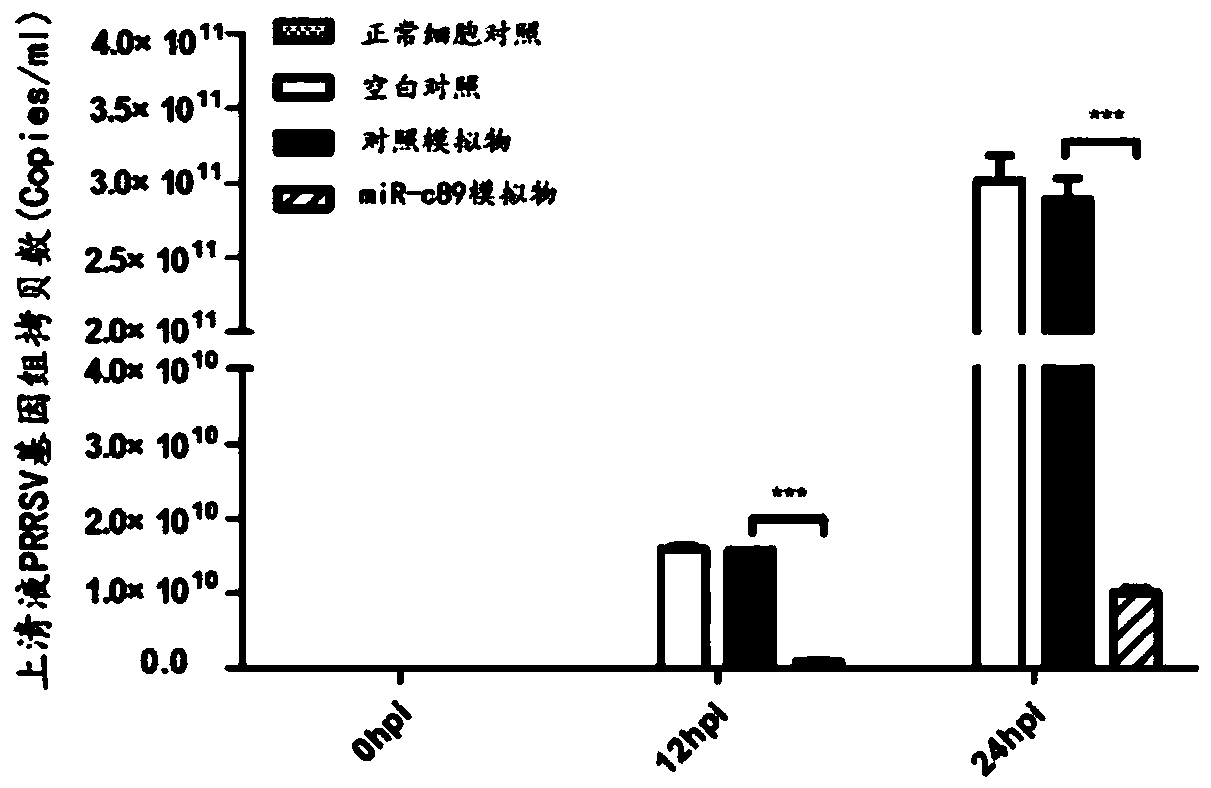Swine-origin miR-c89 capable of resisting PRRSV (Porcine reproductive and respiratory syndrome virus) infection, and application thereof
A mir-c89, porcine-derived technology is applied to porcine-derived miR-c89 against PRRSV infection and its application fields, which can solve the problems of limited protection and no anti-PRRS virus.
- Summary
- Abstract
- Description
- Claims
- Application Information
AI Technical Summary
Problems solved by technology
Method used
Image
Examples
Embodiment 1
[0037] Effect of miR-c89 on HP-PRRSV replication when first transfecting 50nM miR-c89 mimics in PAMs and then infecting highly pathogenic HP-PRRSV
[0038] (1) miR-c89 mimic transfection and cell inoculation:
[0039] 1) Plating: Isolate porcine alveolar macrophages from the lung tissue of 6-week-old piglets, perform cell counting and plating, and store at 37°C in 5% CO 2 Cultivated in an incubator;
[0040] 2) Transfection: The transfection reagent is Roche's X-tremeGENE siRNA Transfection Reagent, and the transfection is performed according to the operation steps of the transfection reagent. 12 hours after plating, a transfection mixture was prepared (the mock and siRNAtransfection reagent were dissolved in Opti-MEM respectively, and then the two were mixed) and incubated at room temperature for 20 minutes. Take the 24-well plate out of the incubator, wash it with PBS and replace it with Opti-MEM, add the mixture drop by drop, shake and mix well, and culture it in the cell...
Embodiment 2
[0081] Example 2 When PAMs cells were first transfected with 50nM miR-c89 mimic and then infected with low pathogenic N-PRRSV, the effect of miR-c89 on the replication of low pathogenic N-PRRSV
[0082] (1) miR-c89 mimic transfection and cell inoculation:
[0083] Plating, transfection, inoculation (0.1 MOI N-PRRSV CH1a) and collection were the same as in Example 1.
[0084] 2. RT-qPCR detection of relative expression level of PRRSV ORF7 mRNA
[0085] Extraction of RNA in cells, reverse transcription into cDNA and qPCR detection are the same as in Example 1.
[0086] The result is as Figure 5 As shown, when PAMs cells were transfected with 50nM miR-c89 mimics and then infected with N-PRRSV CH1a strain, the relative expression of PRRSV ORF7 decreased by 96.6% and 96.6% respectively at 12hpi and 24hpi compared with the control mimic group. 99.3%.
[0087] 3. RT-qPCR detection and determination of the PRRSV genome copy number in the supernatant sample
[0088] Extract the R...
Embodiment 3
[0094] Example 3 When PAMs cells were infected with highly pathogenic HP-PRRSV and transfected with 50nM miR-c89 mimics, the effect of miR-c89 on the replication of highly pathogenic HP-PRRSV
[0095] (1) Cell inoculation and miR-c89 mimic transfection:
[0096] 1) decking is with embodiment 1;
[0097] 2) Infection: Inoculate the HP-PRRSV GD-HD strain at 0.01 MOI 12 hours after plating, and calculate the required virus solution according to the formula PFU=number of cells×MOI=0.7×TCID50; take out the 24-well plate and wash it with PBS Afterwards, add virus diluent and incubate at 37°C;
[0098] 3) Transfection: The transfection reagent is Roche's X-tremeGENE siRNA Transfection Reagent, and the transfection is carried out according to the operation steps of the transfection reagent; after 1 hour of infection, the transfection mixture is prepared (the mock and siRNA transfection reagent are respectively dissolved in Opti-MEM and then mix the two) and incubate at room temperat...
PUM
 Login to View More
Login to View More Abstract
Description
Claims
Application Information
 Login to View More
Login to View More - R&D
- Intellectual Property
- Life Sciences
- Materials
- Tech Scout
- Unparalleled Data Quality
- Higher Quality Content
- 60% Fewer Hallucinations
Browse by: Latest US Patents, China's latest patents, Technical Efficacy Thesaurus, Application Domain, Technology Topic, Popular Technical Reports.
© 2025 PatSnap. All rights reserved.Legal|Privacy policy|Modern Slavery Act Transparency Statement|Sitemap|About US| Contact US: help@patsnap.com



